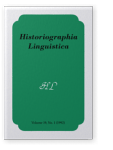A 16th-century case of acquired Dysgraphia
The purpose of this article is to draw attention to one of the earliest historical reports, to the authors’ knowledge, of a specific acquired agraphia: the first-hand account of a man who lost his ability to use letters in writing as a result of a battle injury in 1536. The description occurs as an interpolation in Thomas Wilson’s Arte of Rhetorique (1553), in the course of a discussion of the localisation of the memory in the head. The case is described in sufficient detail to allow a tentative identification of the sort of disorder that was involved.
References
Alston, Robin C[afrae]
1969 A Bibliography of the English Language from the Invention of Printing to the Year 1800. Bradford, U.K.: Printed for the author by Ernest Cummins.

Benton, Arthur L. & Robert J. Joynt
trans. 1960 “
Early Descriptions of Aphasia”.
Archives of Neurology 31.205–222.


Binns, James W.
1990 Intellectual Culture in Elizabethan and Jacobean England: The Latin writings of the age. Leeds: Francis Cairns.

Bouton, Charles P[ierre]
1991 Neurolinguistics: Historical and theoretical perspectives. Transl. by
Teence MacNamee. New York & London: Plenum Press.


Burton, Robert
1621 The Anatomy of Melancholy. Oxford: Henry Cripps. (Critical ed. by
Thomas C. Faulkner,
Nicolas K. Kiessling &
Rhonda L. Blair, 21 vols. Oxford: Clarendon Press 1989–90.)


Caplan, Harry
ed. 1954 Ad C. Herennium: De Ratione Dicendi (Rhetorica ad Herennium). Cambridge, Mass.: Harvard Univ. Press.

Clarke, Edwin & Kenneth Dewhurst
1972 An Illustrated History of Brain Function. Oxford: Sandford Publications.

Dewhurst, Kenneth
1980 Thomas Willis’s Oxford Lectures. Ibid.

Ellis, Andrew W.
1983 “
Normal Writing Processes and Peripheral Acquired Dysgraphia”.
Language and Cognitive Processes 31.99–127.


Ellis, Andrew W. & Andrew W. Young
1988 Human Cognitive Neuropsychology. Hillsdale, N.J. & Hove, U.K.: Lawrence Erlbaum.

Engelhart, G. J.
1947 “
The Relation of Sherry’s Treatise of Schemes and Tropes to Wilson’s Arte of Rhetorique
”.
PMLA 621.76–82.


Galen, Claudius
(c.130–201 A.D.). 1824 “
De Locis Affectis”.
Claudii Galeni Opera Omnia. Editionem curavit
D. Carolus Gottlob Kühn. Vol.VIII1. Leipzig: Carolus Cnobloch.

Howell, Wilbur S.
1956 Logic and Rhetoric in England, 1500–1700. Princeton: Princeton Univ. Press.

O’Neill, Ynez Violé
1980 Speech and Speech Disorders in Western Thought before 1700. Westport, Connecticut: Greenwood Press.

Pollard, A. F.
1909 “
Thomas Wilson”.
Dictionary of National Biography ed. by
Sidney Lee, Vol.211, 603–607. London: Smith, Elder & Co.

Roeltgen, D. P. & K. M. Heilman
1985 “
Review of Agraphia and a Proposal for an Anatomically Based Neuropsychological Model of Writing”.
Applied Psycholinguistics 61.205–230.


Wagner, R. H.
1929 “
Wilson and His Sources”.
The Quarterly Journal of Speech 151.530–532.


Walker, Obadiah
1673 Of Education. Oxford: At the Theater.

Willis, Thomas
1664 De Cerebri Anatome. London:
Jo. Martyn &
Ja. Allestry. [A reprint of the 1681 English translation of this work can be found in
Thomas Willis,
The Anatomy of the Brain ed. by
William Feindel, Montreal: McGill Univ. Press 1965.]

Wilson, Thomas
1553 The Arte of Rhetorique, for the vse of all suche as are studious of Eloquence, sette forth in English, by Thomas Wilson. London: Printed by Richard Grafton.

Wollock, Jeffrey
1990 “
Communication Disorder in Renaissance Italy: An unreported case analysis by H. Mercurialis (1530–1606)”.
Journal of Communication Disorders 231.1–30.


Yates, Frances A.
1966 The Art of Memory. London: Routledge & Kegan Paul.

Cited by
Cited by 1 other publications
Lorch, Marjorie
2013.
Written Language Production Disorders: Historical and Recent Perspectives.
Current Neurology and Neuroscience Reports 13:8

This list is based on CrossRef data as of 3 july 2024. Please note that it may not be complete. Sources presented here have been supplied by the respective publishers.
Any errors therein should be reported to them.
